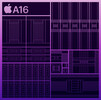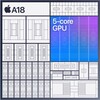Apple A16 Bionic vs Apple A18 vs Apple A6
Apple A16 Bionic
► remove from comparison
The Apple A16 Bionic is a System on a Chip (SoC) from Apple that is found in the iPhone 14 Pro (2022) models. It offers 6 cores divided in two performance cores (codename Everest, up to 3.46 GHz) and four power-efficiency cores (codename Sawtooth, up to 2.02). According to Apple, the most improvements were made to the efficiency cores and the improved memory bandwidth (+50% thanks to LPDDR5). According to the die analysis from angstronomics, the e-core cluster still has the same 4 MB L2 cache, but the p-cores now offer 16 MB L2 cache. The SLC (System Level Cache) however seems to be reduced to 24 MB.
The Neural Engine still offers 16 cores and offers an increased performance of 17 TOPS (vs. 15.8 of the A15) for AI tasks. The integrated graphics engine still offers 5 cores and benefits mostly from the higher memory bandwidth. The new display engine supports adaptive refresh rates down to 1 Hz, the new always-on display, and improved anti-aliasing (for the dynamic island animations).
The CPU performance only shows small improvements to the last generation (Apple A15 Bionic). Still, the A16 is by far the fastest mobile CPU for smartphones and leaves e.g. the Snapdragon 8+ Gen 1 easily behind (in Geekbench 5.4 single- and multi-thread tests).
The chip is manufactured on the modern 4nm process at TSMC and integrates nearly 16 billion transistors (compared to the 15.8 billion of the A15 and 11.8 of the A14). Apple emphasized on efficiency and e.g. mentioned 20% power savings for the big performance cores and class-leading efficiency of the e-cores.
Apple A18
► remove from comparison
The Apple A18 is a powerful smartphone processor and formal successor to the A16. This new member of the Apple A processor series debuted in September 2024 alongside the iPhone 16 and iPhone 16 Plus; it features 2 performance cores and 4 efficient cores along with a 35 TOPS NPU and the 5-core A18 GPU.
The chip is normally paired with 8 GB of RAM. It is said to be in large part based on the v9.2A ARM microarchitecture for near-Apple M4 IPC. 5G, Wi-Fi 7, Bluetooth 5.3, various satellite navigation systems and NFC are all supported here.
The more expensive A18 Pro SoC has the same 2 P-cores and 4 E-cores running at slightly higher clock speeds; its graphics adapter is on the other hand significantly faster than what the A18 has. Another crucial little detail is that USB 3.x support is either missing, or disabled somehow on the A18 for USB 2.0 speeds only whereas the A18 Pro has no such issue.
Performance
Multi-threaded benchmarks put it in the same ballpark as the Snapdragon 8 Gen 3 and the Dimensity 9300. As expected from Apple, the A-series processor delivers breathtaking single-thread performance that just about matches the significantly more power-hungry Apple M3 chip. This suggests the P-cores can almost hit the 4 GHz mark when required.
Graphics
Like any modern graphics adapter, the 5-core A18 GPU is RT-enabled. It delivers benchmark scores that are most comparable to the G715 MP11 and the G615 MP6.
Power consumption
It appears the chip is able to briefly consume up to about 9 W when under high load, with average sustained power consumption figures hovering around 3-4 W.
The pretty modern TSMC N3E manufacturing process makes the A-series chip very power-efficient, as of late 2024.
Apple A6
► remove from comparisonThe Apple A6 is a dual-core SoC found in the iPhone 5 with ARM compatible CPU cores. The A6 was developed by Apple and supports the extended ARMv7s instruction set. The clock rate of the CPU is between 800 to 1200 MHz depending on the CPU load. The integrated GPU is a PowerVR SGX543MP3 at 266 MHz.
| Model | Apple A16 Bionic | Apple A18 | Apple A6 | ||||||||||||||||||||||||||||||||||||||||||||||||
| Codename | Crete | ||||||||||||||||||||||||||||||||||||||||||||||||||
| Series | Apple Apple A-Series | Apple Apple A-Series | Apple Apple A-Series | ||||||||||||||||||||||||||||||||||||||||||||||||
| Clock | 2020 - 3460 MHz | <=3800 MHz | 1000 MHz | ||||||||||||||||||||||||||||||||||||||||||||||||
| L2 Cache | 20 MB | 4 MB | |||||||||||||||||||||||||||||||||||||||||||||||||
| L3 Cache | 24 MB | ||||||||||||||||||||||||||||||||||||||||||||||||||
| Cores / Threads | 6 / 6 | 6 / 6 2 x Apple A18 P-Core 4 x 4.0 GHz Apple A18 E-Core | 2 | ||||||||||||||||||||||||||||||||||||||||||||||||
| Transistors | 16000 Million | ||||||||||||||||||||||||||||||||||||||||||||||||||
| Technology | 4 nm | 3 nm | 32 nm | ||||||||||||||||||||||||||||||||||||||||||||||||
| Features | ARMv8 Instruction Set, Machine Learning Controller, 16-Core Neural Engine, Secure Enclave, Advanced Image Signal Processor | 16-core Neural Engine, USB 2.0 (480 Mbps) | |||||||||||||||||||||||||||||||||||||||||||||||||
| iGPU | Apple A16 GPU 5-Core | Apple A18 GPU | |||||||||||||||||||||||||||||||||||||||||||||||||
| Architecture | ARM | ARM | ARM | ||||||||||||||||||||||||||||||||||||||||||||||||
| Announced | |||||||||||||||||||||||||||||||||||||||||||||||||||
| Series: Apple A-Series |
|
| |||||||||||||||||||||||||||||||||||||||||||||||||
| TDP Turbo PL2 | 9 Watt |
Benchmarks
Average Benchmarks Apple A16 Bionic → 100% n=2
Average Benchmarks Apple A18 → 140% n=2
Average Benchmarks Apple A6 → 117% n=2
* Smaller numbers mean a higher performance
1 This benchmark is not used for the average calculation












